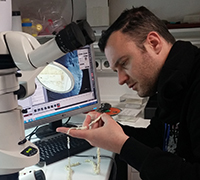 Georgios L. Georgalis. Dipartimento di Scienze della Terra, Università di Torino, Via Valperga Caluso 35, 10125 Torino, Italy. dimetrodon82@gmail.com
Georgios L. Georgalis. Dipartimento di Scienze della Terra, Università di Torino, Via Valperga Caluso 35, 10125 Torino, Italy. dimetrodon82@gmail.com
Department of Geosciences, University of Fribourg / Freiburg, Chemin du Musée 6, 1700 Fribourg, Switzerland.
Department of Ecology, Laboratory of Evolutionary Biology, Faculty of Natural Sciences, Comenius University in Bratislava, Mlynská dolina, 84215 Bratislava, Slovakia.
Georgios Georgalis obtained his PhD at the University of Fribourg (Department of Geosciences), Switzerland in cotutelle with the University of Turin (Department of Earth Sciences), Italy, in 2018. His thesis was focusing on fossil reptiles from the Aegean region. His main research interests are the evolution, systematics, and biogeography of Cenozoic lizards, snakes, and turtles from the Western Palaearctic. He is currently a post-doc at the Department of Earth Sciences, University of Turin, Italy, focusing on Neogene herpetofaunas from southern Europe.

 Andrea Villa. Bayerische Staatssammlung für Paläontologie und Geologie, Richard-Wagner-Straße 10, 80333 Munich, Germany. a.villa@unito.it
Andrea Villa. Bayerische Staatssammlung für Paläontologie und Geologie, Richard-Wagner-Straße 10, 80333 Munich, Germany. a.villa@unito.it
Dipartimento di Scienze della Terra, Università di Torino, Via Valperga Caluso 35, 10125 Torino, Italy.
Andrea Villa obtained his PhD in Earth Sciences at the University of Turin, Italy, in 2018, with a thesis focused on fossil lizards from the Neogene and Quaternary of Europe. His main research topics are the fossil herpetofaunas of Europe and Africa and the comparative morphology of amphibians and reptiles. He currently works as Humboldt Research Fellow at the Bayerische Staatssammlung für Paläontologie und Geologie in Munich, studying rhynchocephalians from the Jurassic of Germany.

 Martin Ivanov. Department of Geological Sciences, Faculty of Science, Masaryk University, Kotlářská 2, 611 37 Brno, Czech Republic. mivanov@sci.muni.cz
Martin Ivanov. Department of Geological Sciences, Faculty of Science, Masaryk University, Kotlářská 2, 611 37 Brno, Czech Republic. mivanov@sci.muni.cz
Martin Ivanov obtained his PhD in Earth Sciences at the Masaryk University, Brno in 1997, with a thesis focused on the European Neogene and Quaternary snakes. His main research topics are the comparative osteology of snakes and the Cenozoic evolution of Eurasian amphibian and squamate assemblages, with special attention to the changes in palaeoenvironment. He currently works as an Associate Professor at the Department of Geological Sciences, Faculty of Science, Masaryk University in Brno, Czech Republic.

 Davit Vasilyan. JURASSICA Museum, Fontenais 21, 2900 Porrentruy, Switzerland.
Davit Vasilyan. JURASSICA Museum, Fontenais 21, 2900 Porrentruy, Switzerland.
Department of Geosciences, University of Fribourg / Freiburg, Chemin du Musée 6, 1700 Fribourg, Switzerland. davitvasilyan@gmail.com
Davit Vasilyan is a researcher at the JURASSICA Museum, Porrentruy, Switzerland and associate lecturer at the University of Fribourg, Switzerland. He received his first PhD at the National Academy of Sciences or Republic of Armenia in 2009 and the second one at the University of Tübingen, Germany in 2014. His research focuses on Cenozoic freshwater fishes, amphibians and reptiles from Western Eurasia.

 Massimo Delfino. Dipartimento di Scienze della Terra, Università di Torino, Via Valperga Caluso 35, 10125 Torino, Italy. massimo.delfino@unito.it
Massimo Delfino. Dipartimento di Scienze della Terra, Università di Torino, Via Valperga Caluso 35, 10125 Torino, Italy. massimo.delfino@unito.it
Institut Català de Paleontologia Miquel Crusafont, Universitat Autònoma de Barcelona, Edifici ICTA-ICP, Carrer de les Columnes s/n, Campus de la UAB, 08193 Cerdanyola del Vallès, Barcelona, Spain.
Massimo Delfino is a vertebrate paleontologist whose research activity is focused on the fossil record, morphology, taxonomy and biogeography of amphibians and reptiles. The main research lines are related to the contribution of the fossil record to the phylogeny of crocodylians and the evolution of the European and Mediterranean herpetological assemblages. He has collaborated to the identification and interpretation of herpetofaunistic assemblages associated to hominoid remains found in Eritrea, Georgia, Indonesia, Kenya, Italy, Oman, and Sudan.

